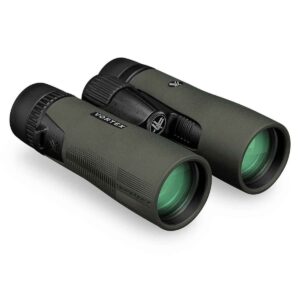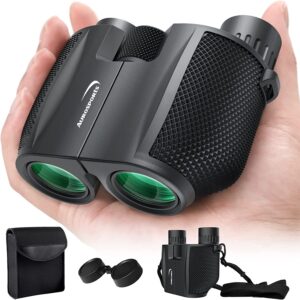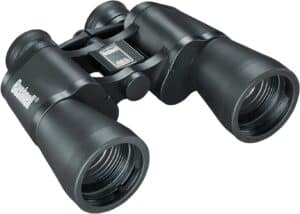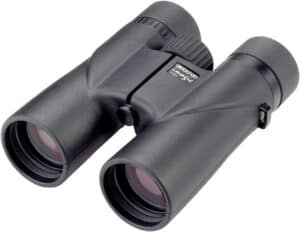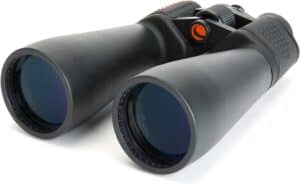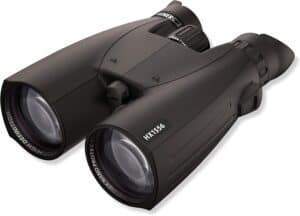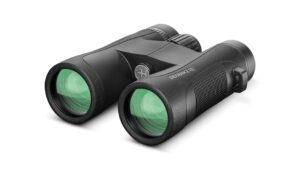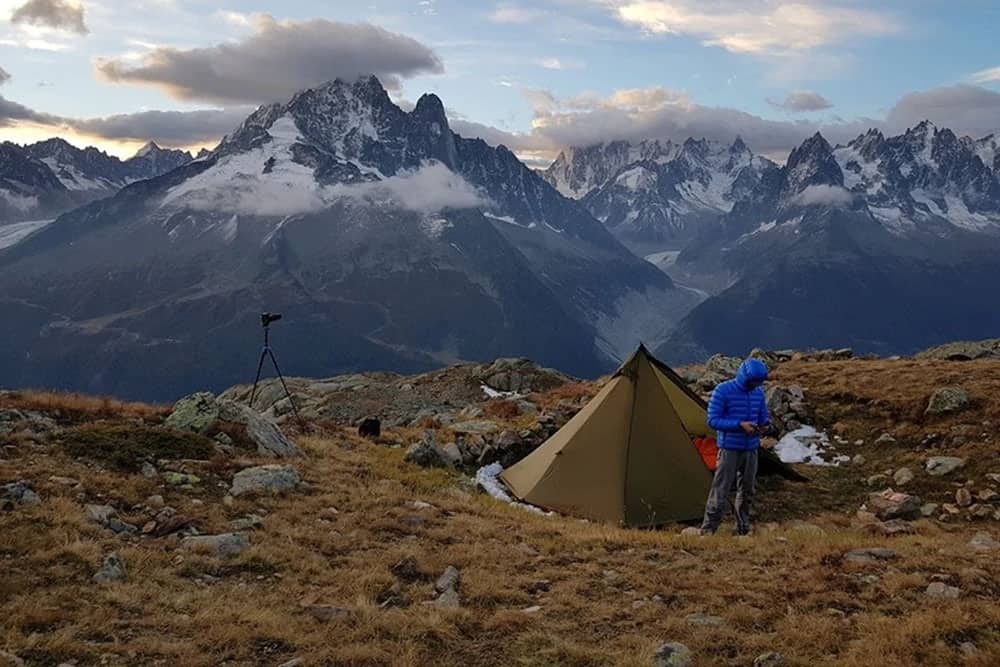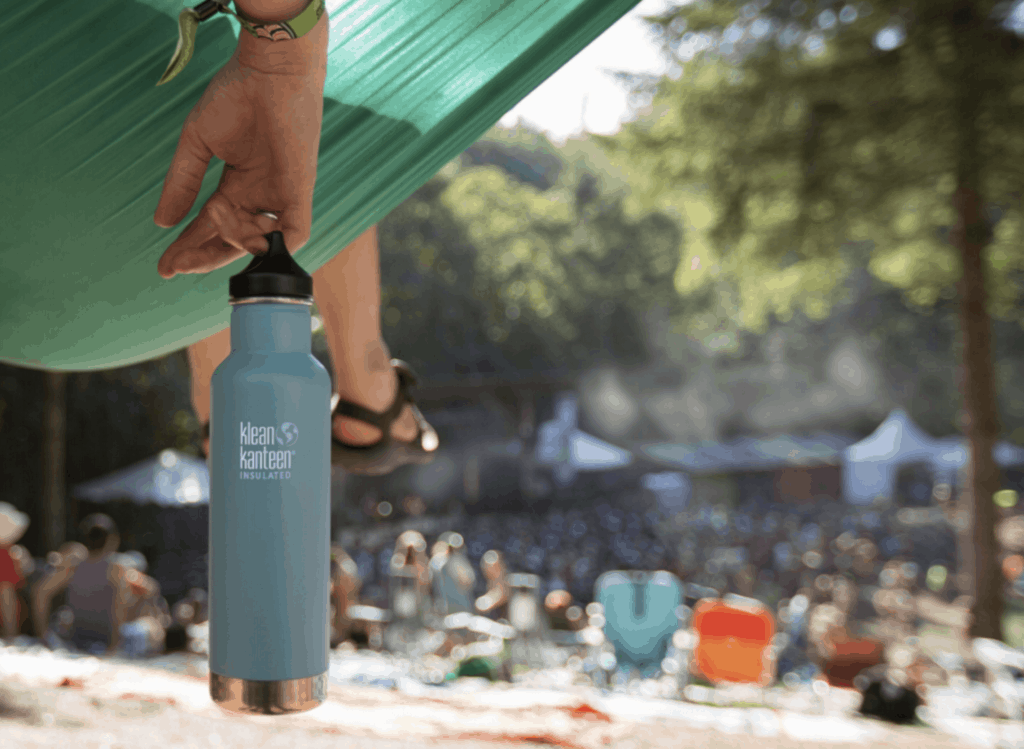Binoculars are an indispensable tool for a variety of outdoor activities. Whenever you need to get a closer look at an animal or landmark way off in the distance, you need a great pair of binoculars easily accessible. Hunters use them to identify the right species to target during certain seasons. Birders check off their favorite hummingbird or swallow species by using binoculars to get a closer look.
These are just a couple of quick examples, but there are many field uses for binoculars. Even just keeping a pair handy in your house makes viewing local wildlife a whole lot more fun. Today, there are so many models to choose from that it can be a bit overwhelming. Our list of the 10 Best Binoculars of 2022 will help you choose the set that’s right for you. And be sure to read on to our Buyer’s Guide for more tips on selecting the best binoculars that’ll fit your specific needs.
1. Vortex Optics Diamondback HD
The Vortex Optics Diamondback HD binoculars are an excellent option for anyone that needs binoculars that will perform in extreme weather conditions. Argon purging of these binoculars provides enhanced waterproof and fog proof performance and durability.
These binoculars also deliver impressive optical quality via dielectric, fully multi-coated lenses that transmit more light and clearer, brighter images. They also feature a sleek, short hinge design with rubber armor and thumb indents that leave room for your hands and create an easier, more secure, non-slip grip.
2. Aurosports 10×25
These folding binoculars from Aurosports are best for getting a better view at outdoor sports games and concerts, but their compact design also makes them great for bird watching. They come with low-level night vision, but they won’t be able to be used in complete darkness.
These binoculars also offer a large field of view with 10x magnification and a 25-millimeter objective lens. This gives you the ability to focus in on an object in detail from even 1000 yards out. They also feature a fully multi-coated lens and a hyper-durable anti-slip grip, in addition to being waterproof. These are a great budget friendly option for leisure use.
3. NOPTIX Binoculars
This binocular set is a great option for anyone looking for an all-in-one kit to get started. Along with the 10×42 NOPTIX binoculars, the kit includes an attachable lens cap, smartphone adapter, tripod & bracket mount, comfortable neck strap, carrying case, cleaning cloth, and an easy-to-follow user’s manual. These binoculars feature a beginner-friendly design that makes them easy to hold and a breeze to focus.
The NOPTIX binoculars offer 10x magnification power, a 42-millimeter objective lens diameter, and adjustable eyecups. They boast fully multi-coated, antireflective lenses that provide crystal clear viewing quality and maximum eye relief for a comfortable viewing experience. Additionally, these binoculars are built with a soft rubber body design and intended for a wide range of uses. They also feature a waterproof rating of IPx3, which means they can withstand heavy rain and still function optimally.
4. Bushnell Falcon 10×50
The quality optics and stunning HD clarity of the Bushnell Falcon make it an excellent choice for stadium sports, bird watching, hunting, and other outdoor activities. These binoculars offer a durable design and rubberized, abrasion-resistant finish.
They also boast fold-down eyecups that protect lenses from scratching if you wear eyeglasses or sunglasses on bright days. Additionally, they feature 10x magnification and 50-millimeter lens diameter, as well as an auto-focusing Porro prism.
5. Opticron Imagic BGA VHD
Birders unite! These are some exceptional binoculars for birding. They’re lightweight, compact, and boast a roof prism design with textured rubber armoring. They’re also nitrogen-filled to make them waterproof and resistant to dust and dirt.
These binoculars offer three-stage, twist type, retractable eyecups with eyepieces that provide a wide field and long eye relief. They also feature a fully multi-coated VHD optical system with high quality, phase corrected PGK prism units and Oasis prism coating.
6. Pentax U-Series Papilio II
The U-Series Papilio II from Pentax is a unique set of binoculars that are the perfect choice for anyone that wants to buy a set that’s going to last. They boast a uni-body design that enhances durability by locking objective lenses in a single housing and synchronizing the eyepiece movement. This minimizes moving parts and makes them last for years.
These binoculars also feature aspherical lens elements that are included to ensure exceptional edge-to-edge sharpness and fully multi-coated optics to guarantee maximum light transmission for the highest quality viewing possible.
7. Celestron SkyMaster Giant
The Celestron SkyMaster Giant is designed to offer maximum image brightness in low-light and long-range conditions. It achieves this through a large, 70-millimeter objective lens and a large aperture that’s perfect for low light conditions and activities like stargazing.
These binoculars also boast a 13-millimeter long eye relief that’s great for eyeglass wearers and a diopter adjustment for fine focusing. Finally, this pair of binoculars feature multi-coated optics and an angular field of view of 4.4 degrees.
8. Tract Toric 8×42
The award-winning Toric binocular from Tract was specifically designed to be a wide angle binocular and it allows for a field of view of 377 at 1,000 yards. It also offers a specialized eyecup design that makes it an excellent choice for hunters and birders alike.
These binoculars boast an enhanced ocular size that provides for a wider field of view and longer eye relief. This also minimizes the blackout that can sometimes occur with improper eye position. They also feature scratch-resistant, fully multi-coated lenses that prevent oils, dirt, and dust from adhering to the surface of the glass.
9. Steiner HX 15×56
These high-powered binoculars are truly a game changer for hunters. They will make game finding much easier with their Fast-Close-Focus feature that allows quick and effortless focusing for absolute sharpness from close-up to infinity.
The Steiner HX comes with a redesigned frame that makes them easier to grip and more comfortable for extended use. They’re also outfitted with ergonomic eyecups that are comfortable and protect your eyes from sidelight and drafts.
10. Hawke Endurance ED 8×42
A true “bang for your buck” type purchase, the Hawke Endurance ED binoculars are a great all-around choice for anyone looking to get the most for their money. These binoculars offer 8x magnification and a 42-millimeter lens.
They also offer fully multi-coated optics, nitrogen-filled, waterproof, and fog proof specifications, and dimensions of just 4 x 8 x 10 inches. This particular model also comes with a case and a neck strap to help guarantee safe storage, transportation, and carrying.
Buyer’s Guide
J.P. Lemiere invented the first binocular telescope in 1825 (1), but the modern prism binocular traces its origins back to Ignatio Porro’s application to patent his prism erecting system in 1854. In the 160-plus years that have passed since then, binoculars have vastly increased in their function and capability. You can now find a binocular designed specifically for almost any purpose you might imagine. To help you find the pair that’s right for your needs, our Buyer’s Guide will focus on several major considerations: prism types, budget, intended purpose, and user requirements.
Prism Types
The two main prism types you’ll find in modern binoculars: roof prism and Porro prism. In both systems, prisms serve to correct the orientation of the view both horizontally and vertically. This makes the image you see when you look through binoculars appear natural. Without a prism system, the image you’d see through your binoculars would be upside down and flip-flopped.
The roof prism system uses glass elements that are in line with one another. This setup makes them more streamlined and easier to hold. You can see from the image above how the binoculars’ glass elements (shown in blue) are all presented in line with each other.
In a Porro prism system, the glass elements are offset, which provides a greater depth of field and wider field of view in comparison to most roof prism models. The Porro prism system, which actually technically utilizes a “double-Porro prism,” accomplishes this by essentially folding the light path, shortening its length, and spreading the objectives farther apart.
In general, binoculars that utilize the Porro prism system will provide a clearer, higher-quality image. That said, sometimes you’ll evaluate two seemingly similar models and find that they differ greatly in price. Because of the physics involved in designing and manufacturing the roof prism form factor, some binoculars that utilize the roof prism system end up being considerably more expensive than their Porro prism counterparts.
Glass
When comparing binoculars, you need to look closely at the type of glass used for the lenses and the prisms. Generic optical glass is more likely to contain imperfections. When this glass isn’t ground and polished correctly, it can bend light in funky ways and cause certain colors to look skewed. It can also prevent a binocular’s ability to achieve a sharp focus and cause distortion at the edges of the image you see when you look through.
On the other hand, specialized glass is specifically engineered to cause virtually zero distortion and to transmit light optimally without bending it. Some types of specialized glass are low dispersion and extra-low dispersion glass. In general, these types of glass produce clearer and sharper images. They also produce images with higher contrast and true color rendition.
Several models of binoculars nowadays advertise what they call “Eco-glass.” This type of glass is considered to be ecologically friendly because it doesn’t contain lead or arsenic. The lack of these elements in the glass shouldn’t affect image quality, but it can help you rest easier knowing that you’re not contributing to environmental pollution if your lenses break or you need to dispose of your binoculars for any reason.
Budget
The amount of money you intend to spend on a new set of binoculars is often the most important consideration. The binoculars we’ve featured in this article range from just under $30 to upwards of $1,100. This is a wide range that you’ll find yourself navigating in search for the right type of binoculars. Generally, unless you’re looking for extremely high-powered binoculars that are made for a very specific purpose (such as big game hunting or bird watching) you won’t find yourself in the upper percentage of that price range.
However, the binoculars that are available at that upper price range are carefully and meticulously designed for their purpose, which is what makes them such a specialty item. The major reasons for the large price differences between binocular models are the quality of the optics, the types of coatings applied to the lenses, and additional features, such as housing material.
At the end of the day, binoculars that use the Porro prism model are, on average, more cost-effective to manufacture. Because of this, you’ll typically end up getting a higher-quality Porro model with a larger objective for about the same price as a comparable roof prism model.
Intended Purpose
Understanding your intended purpose for buying new binoculars is also a key to making the right selection. You’ll notice that the models included in our top ten list vary greatly in terms of intended purpose. Some are all-around binoculars at a relatively inexpensive price. Others fall in the mid-range on price because they’re optimal for stadium sports and concert watching. And still others that cost a bit more have been designed specifically for hunting, bird watching, or tactical surveillance.
You should ask yourself what activities you’d primarily be bringing your new set of binoculars along for. This will help you narrow down your options to models that are specifically designed for those activities and, ultimately, choose a pair that’ll be useful and effective. For example, most hunters and birders won’t need a binocular that provides much more than 8x magnification, but they will want an objective lens diameter that exceeds 50 millimeters. This produces a wider exit pupil, which is the size of the focused light that hits the eye.
User Requirements
The final consideration is what unique attributes of yours might affect your ability to use your new binoculars. If you wear eyeglasses, for example, eye relief is a really important factor to make sure that you can use binoculars effectively. Additionally, you might consider how far the binocular can be held away from the eye and still present the full field of view.
For eyeglass wearers or those who wish to look through binoculars while wearing sunglasses on bright days, extended or long eye relief is a piece of binocular design that must be included for effective use. Consider factors like this to ensure that you choose a set of binoculars that you’ll actually be able to put to good use.
Frequently Asked Questions
With many technological items (especially those for which you may end up paying top dollar), it’s best to know as much as possible before making a purchase. Our Frequently Asked Questions section will help you learn more about how different binoculars are best suited to different purposes.
What are the best binoculars for the money?
When it comes to value for your dollar, it’s really hard to beat the Hawke Endurance ED Series (2). They come in under $300 and serve a variety of useful purposes. For binoculars that feature fully multi-coated optics, waterproof and fogproof capabilities, and compact dimensions, less than $300 is a steal!
What are the best binoculars for birding?
Many experts have agreed that the Opticron Imagic BGA VHD (3) are the best binoculars for birding. They’re compact and easy-to-transport and they provide excellent detail when trying to identify even the smallest and most elusive of species.
What are the best binoculars for hunting?
When it comes to hunting, you’ll probably narrow down your options to either the Tract Toric (4) or the Steiner HX binoculars. Both are excellent binoculars for hunting, but the best model for you will depend, of course, on your specific preferences.
What are the best compact binoculars?
At just 4.5 x 4.5 x 1.5 inches in dimensions, the Carson RD Series binoculars are a low-cost binocular option that’s compact and easy to transport. Best of all, they come with a hard case, lens covers, a neck strap, and a lens cloth. They’re even backed by Carson’s No-Fault, No Hassle Warranty (5).
What does ‘exit pupil’ mean?
Exit pupil is the measurement of the size of the focused circle of light that hits your eye when you look through binoculars. This relates most practically to how well binoculars will perform in low light. You can see a binocular’s exit pupil by holding them eight to ten inches away from your face and taking notice of the small dots of light in the center of the eyepieces. A binocular’s exit pupil diameter should always be larger than the pupil of your eye. Exit pupil is directly affected by the binocular’s objective diameter and the magnification.
Can you explain ‘field of view’?
Sure! ‘Field of view’ is the size of an area that can be viewed using the binoculars. This depends on how far away the objects you’re looking at are from you. Many binoculars tell you their field of view at 1,000 yards. Generally, higher-powered binoculars offer a smaller field of view because they’re providing more detail on a more specific area. Lower powered binoculars, then, typically provide a larger field of view. Sometimes, the field of view is expressed in degrees, rather than in feet. This is often referred to as ‘angular field of view’. You can convert an angular field of view to the more practical linear field of view by multiplying the ‘angular field’ by a factor of 52.5.
What are ‘lens coatings’?
Lens coatings help to remove glare and allow as much light as possible to enter the optics. They come in the form of a film that, when applied to the lens, reduces glare and reflections while increasing light transmission and contrast. They also help to make colors look more vivid. For binoculars to function optimally, light reflection needs to be minimized because any light that is reflected never reaches the viewer’s eyes. By eliminating reflections, lens coatings help binoculars produce brighter and sharper images.
There are generally four levels of lens coating: coated, fully coated, multi-coated, and fully multi-coated. Coated lenses have a single layer on at least one lens. Fully coated lenses have a single layer on all air-to-glass surfaces of lenses. Multi-coated lenses have multiple layers on at least one lens. And fully multi-coated lenses have multiple layers on all air-to-glass surfaces. Fully multi-coated lens coatings are engineered to be the most effective across a wide spectrum of wavelengths and they also provide the best performance.
What is a ‘roof prism’ vs. a ‘porro prism’ system?
With a roof prism system, prisms overlap closely and allow the objective lenses to line up directly with the eyepiece. This gives you (the viewer) a slim, streamlined shape in which the lenses and prisms that magnify and correct the image are in a straight line. In a Porro prism system, the objective or front lens is offset from the eyepiece. This provides greater depth perception and generally offers a wider field of view.
What is ‘minimum focus distance’?
Another term that you’ll see come up when looking at binoculars is minimum focus distance. This is the minimum distance at which objects you view through your binoculars remain in focus. A minimum focus distance of fewer than six feet is noteworthy for full-size binoculars. As the magnification of a binocular is increased, minimum focus distance also increases.
Summary
Many folks are unaware of the difference between a cheap set of binoculars and those that are specifically designed for a unique purpose. But if you want a clear image that actually helps you learn more about what you’re looking at than you could learn with just the naked eye, you’ll need a quality set. We hope that the information we’ve set forth above has been helpful in your selection process and we wish you the best of luck finding the best set of binoculars for your next adventure!
